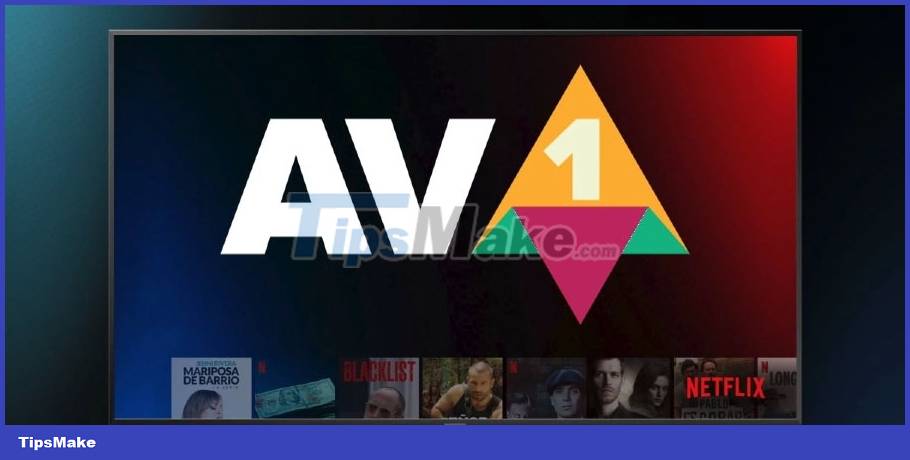What is the AV1 codec? Used for what purpose?
Codecs play an important role in the distribution of content on the Internet. After all, it is thanks to these codecs that Terabytes of RAW footage from your camera can be compressed into Gigabytes - allowing us to view high-resolution footage on the Internet.
However, to make this compression more efficient, new codecs keep entering the market, and the AV1 codec is a prime example of the ever-changing codec ecosystem. This begs the question of what the AV1 codec is and what is it used for. Join TipsMake to find the answer through the following article!
What is AV1 video codec?
Developed by Alliance for Open Media, a non-profit organization, AV1 is an unlicensed video codec. Therefore, anyone can use the codec without paying royalties to the developers. Founded by Intel, Amazon, Apple, Netflix and other tech giants, Alliance for Open Media released AV1 in 2018.

The main goal of the AV1 codec is to reduce the file size after compression without affecting the quality. This reduction in capacity is necessary because the display resolution of the content we stream is increasing. For example, in the past, DVDs with 480p content and similar content could be compressed using MPEG-2, but with Blue Ray, the compression standard had to be improved when the resolution was increased to 1080p.
The growing demand for video quality is what led to the development of h.254 (AVC). As 4K and 8K came out, new compression standards like AV1 were needed.
The main goal of the AV1 codec is to reduce the bitrate of a video while maintaining quality. Therefore, higher quality videos can be uploaded to the Internet without any quality loss. In terms of numbers, AV1 offers 30% better compression at the same bit rate than HEVC. This increased compression efficiency enables smoother playback over low bandwidth for both high and low resolutions.
In addition to these compression improvements, AV1 is designed with hardware in mind. This approach improves the encoding process when using hardware with special AV1 encoding and decoding units. Some of the new SoCs and GPUs include Snapdragon 8 Gen 2, Samsung Exynos 2200, MediaTek Dimensity 1000 5G, Google Tensor G2, Nvidia's RTX 4000-Series as well as Intel Xe and Arc GPUs that support hardware-accelerated decoding. for AV1 codecs.
What is the AV1 video codec used for?
Since AV1 improves compression efficiency in video encoding, it is used by every tech giant when it comes to video distribution. Meta, for example, uses AV1 to stream reels and videos on Instagram and Facebook and has reported up to 30% efficiency when using the codec.
Additionally, both Google and Netflix use AV1 to stream video in apps like YouTube and Google Duo for better quality on low-bandwidth connections.
Not only this, but the streaming community can also benefit from AV1 if they have dedicated hardware that supports it. The codec not only helps to deliver better quality when streaming, but it also delivers higher gaming FPS, as the GPU is not interrupted when processing the streaming output due to the availability of dedicated hardware.

Creators who shoot high-quality footage can also reap the benefits of AV1 as it will reduce upload times while delivering better quality to their audience, improving both productivity and visibility. customer satisfaction.
Is AV1 the codec of the future?
AV1 is the game changer when it comes to video compression efficiency. However, this increased efficiency comes at the expense of high coding times and lack of compatibility, but both of these are sure to improve in the future. Reality shows that AV1 may be the future of codecs, but older codecs like VP9, H.254 and H.256 have their own merits as they offer better compatibility and lower encoding times on current hardware.
You should read it
- The benchmark of Facebook shows AV1 Video Codec very fast
- 3 best free Codec Media packages for Windows 7
- Microsoft launched AV1 codec for Windows 10
- Learn about LDAC, aptX, LHDC: High-Resolution Bluetooth Audio Codecs
- Google Tensor G3 is the world's first smartphone processor to support AV1 encoding at 4K 60FPS
- What is VVC (Versatile Video Coding)?
- Install additional Codec to see all Video formats with Windows Media Player
- Microsoft supports the AAC Bluetooth audio codec on Windows 10
May be interested
- What is Apple's Neural Engine? How does it work?
 your iphone, ipad, mac, and apple tv use a dedicated npu (neural processing unit) called the apple neural engine (ane) that is much faster and more energy efficient than a cpu or gpu.
your iphone, ipad, mac, and apple tv use a dedicated npu (neural processing unit) called the apple neural engine (ane) that is much faster and more energy efficient than a cpu or gpu. - How to enable security shortcuts on Xiaomi phones
 on xiaomi phones, there is a security application with tools to optimize the system faster and better such as optimizing battery, performance, cleaning data, ...
on xiaomi phones, there is a security application with tools to optimize the system faster and better such as optimizing battery, performance, cleaning data, ... - How to save React form data in Mongo Database
 try adding mongodb to your web stack to see how easy it is to store and query form data!
try adding mongodb to your web stack to see how easy it is to store and query form data! - 7 security mistakes you often make
 although revolutionary, the ease and convenience of disseminating information online also lurks some security threats. many people have unknowingly engaged in risky online activities.
although revolutionary, the ease and convenience of disseminating information online also lurks some security threats. many people have unknowingly engaged in risky online activities. - SnapSave - The world's first free 2K 4K Facebook video downloader
 snapsave.app is known as the best facebook video downloader today. when using snapsave, users can easily download movies and clips to their phone, tablet or pc in 4k quality.
snapsave.app is known as the best facebook video downloader today. when using snapsave, users can easily download movies and clips to their phone, tablet or pc in 4k quality. - 3DLUT mobile - Professional photo color correction app
 3dlut mobile is a professional photo and video editing application for mobile phones that allows users to adjust the look of photos/videos based on preferences.
3dlut mobile is a professional photo and video editing application for mobile phones that allows users to adjust the look of photos/videos based on preferences.






 How to install AV1 codec in Windows 10
How to install AV1 codec in Windows 10 What is a codec? Why do I need codecs?
What is a codec? Why do I need codecs? The benchmark of Facebook shows AV1 Video Codec very fast
The benchmark of Facebook shows AV1 Video Codec very fast 3 best free Codec Media packages for Windows 7
3 best free Codec Media packages for Windows 7 YouTube switched to the AV1 codec, which helps increase video quality without consuming a lot of data
YouTube switched to the AV1 codec, which helps increase video quality without consuming a lot of data